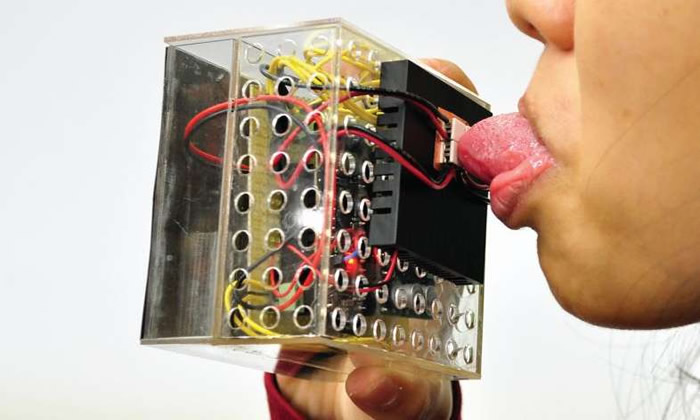Let VR tickle your tastebuds
Imagine what the tourism industry could do with VR technology extending sensory stimulation beyond the eyes and ears. Imagine inviting prospective restaurant clients in virtual reality mode to the meat, fish and chicken specialties, pizza or chocolate cakes. Imagine any number of applications where the sensory experience in virtual reality expands.
Scientists are focusing on VR technology that can fool you into thinking you are tasting food that is not of course really there. Researchers from Singapore and another team from Japan have their own studies that explore the realm of tasting and even chewing.
Vlad Dudau, Neowin, said these explorers managed to replicate the tastes and textures of different foods.
A recent conference in Japan on user interface was given much ‘food’ tech for thought.
The work titled “Virtual Sweet: Simulating Sweet Sensation Using Thermal Stimulation on the Tip of the Tongue,” explored what it is like to be tasting sweet food virtually.
“Being a pleasurable sensation, sweetness is recognized as the most preferred sensation among the five primary taste sensations. In this paper, we present a novel method to virtually simulate the sensation of sweetness by applying thermal stimulation to the tip of the human tongue. To digitally simulate the sensation of sweetness, the system delivers rapid heating and cooling stimuli to the tongue via a 2×2 grid of Peltier elements. To achieve distinct, controlled, and synchronized temperature variations in the stimuli, a control module is used to regulate each of the Peltier elements. Results from our preliminary experiments suggest that the participants were able to perceive mild sweetness on the tip of their tongue while using the proposed system.”
Nimesha Ranasinghe and Ellen Yi-Luen Do of the National University of Singapore are the two explorers. This is a device where changes in temperature serve to mimic the sensation of sweetness on the tongue.
Victoria Turk in New Scientist wrote about what their technology does: “The user places the tip of their tongue on a square of thermoelectric elements that are rapidly heated or cooled, hijacking thermally sensitive neurons that normally contribute to the sensory code for taste.”
MailOnline described it as a “virtual sweetness instrument” which makes use of “a grid of four elements which generate temperature changes of 5°C in a few seconds. “When applied to the tip of the tongue, said the report, “the temperature change results in a virtual sweet sensation.” A 9V battery is put to use. Results: Out of 15 people, eight registered a very mild sweet taste, said MailOnline.
Applications could include a taste-enhancing technology for dieters. Dr Ranashinghe told MailOnline: ‘We believe this will especially helpful for the people on restricted diets for example salt (hypertension and heart problems) and sugar (diabetics).”
New Scientist said Ranasinghe and Do could see a system like this embedded in a glass or mug to make low sugar drinks taste sweeter.
Another group from the University of Tokyo is using electrodes to stimulate the jaw muscles. Tokyo Researchers Arinobu Niijima and Takefumi Ogawa are reporting results from an electrical muscle stimulation (EMS) test of jaw movements in chewing.
“We propose Electric Food Texture System, which can present virtual food texture such as hardness and elasticity by Electrical Muscle Simulation (EMS) to the masseter muscle,” said the researchers in a video posted last month on their work, ‘Study on Control Method of Virtual Food Texture by Electrical Muscle Stimulation’.
Dudau in Neowin described their experiment, where “scientists attached electrodes to jaw muscles and managed to simulate the sensation of biting into different materials. For example, by varying the electrical stimulation, users reported that while eating a real cookie, it felt like biting into something soft, or chewing something hard alternatively.”
Turk in New Scientist also talked about the Tokyo team who presented “a device that uses electricity to simulate the experience of chewing foods of different textures. Arinobu Niijima and Takefumi Ogawa’s Electric Food Texture System also uses electrodes, but not on the tongue, instead they place them on the masseter muscle – a muscle in the jaw used for chewing – to give sensations of hardness or chewiness as a user bites down. ‘There is no food in the mouth, but users feel as if they are chewing some food due to haptic feedback by electrical muscle stimulation,’ says Niijima.”
Getting into technical details, MailOnline said, “By delivering short pulses of between 100 to 250 Hz they were able to stimulate the masseter muscles, used to chew solid foods.”
So if the ‘sugar’ researchers were looking at taste sensation, these researchers were looking at food texture. They said, “In this paper, we investigated the feasibility to control virtual food texture by EMS.”
The researchers said on their video page, “We conducted an experiment to reveal the relationship of the parameters of EMS and those of virtual food texture. The experimental results show that the higher strength of EMS is, the harder virtual food texture is, and the longer duration of EMS is, the more elastic virtual food texture is.”
If at higher frequency, the sensation was that of eating tougher, chewy food but a longer pulse simulated a more elastic texture.
“There are many people who cannot eat food satisfactorily because of weak jaws, allergies, and diet,” Niijima said in New Scientist.
More information: TechXplore


Comments are closed, but trackbacks and pingbacks are open.